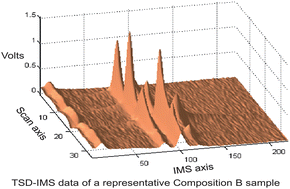Traditional peak-area calibration and the multivariate calibration methods of principal component regression (PCR) and partial least squares (PLS), including unfolded PLS (U-PLS) and multi-way PLS (N-PLS), were evaluated for the quantification of 2,4,6-trinitrotoluene (TNT) and cyclo-1,3,5-trimethylene-2,4,6-trinitramine (RDX) in Composition B explosive mixtures analyzed by temperature step desorption ion mobility spectrometry (TSD-IMS). TSD is a technique used to partially resolve mixture components before ion mobility analysis by exploiting differences in thermal desorption profiles. While TSD was used here, the results and conclusions presented are universally applicable to IMS. Although IMS is used extensively for trace explosive detection, it has not been sufficiently demonstrated in the past for the detailed analysis of specific compositions of explosive mixtures. This manuscript combines IMS with multivariate chemometric data methods to enhance the quantitative performance of IMS needed for detailed explosive analyses. This is demonstrated using data from the replicate TSD-IMS analyses of eight different Composition B samples. The true TNT and RDX concentrations were determined by analyzing the Composition B samples by high performance liquid chromatography with UV absorbance detection. Most of the Composition B samples were found to have distinct TNT and RDX concentrations. The data from each TSD-IMS analysis were a 2-D array that was reduced by averaging into a vector or mean IMS spectrum. Although the mean IMS peaks for TNT and RDX were sufficiently resolved to use peak area to generate linear calibration curves, the peak-area variability was too large to differentiate Composition B samples based on their predicted RDX and TNT concentrations. Applying PCR and PLS on the exact same IMS spectra used for the peak-area study improved quantitative accuracy and precision approximately 3-to 5-fold and 2- to 4-fold, respectively. This in turn improved the probability of correctly identifying Composition B samples based upon the estimated RDX and TNT concentrations from 11% with peak area to 44% and 89% with PLS. The success of PLS over peak area is attributed to multivariate signal averaging and the simultaneous maximization of correlation between the entire span of the IMS mean spectra and the known TNT and RDX concentrations. In this study, PLS also outperformed PCR and had similar quantitative results to U-PLS. In terms of N-PLS, its mean bias values were up to 2.8 times larger and the mean RSD values were at least 40% larger than those obtained by PLS.

You have access to this article
 Please wait while we load your content...
Something went wrong. Try again?
Please wait while we load your content...
Something went wrong. Try again?


 Please wait while we load your content...
Please wait while we load your content...